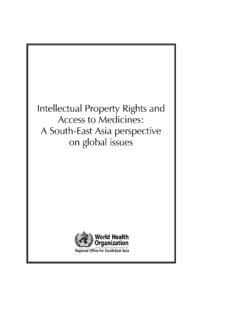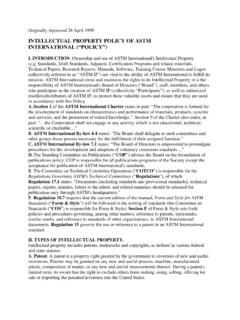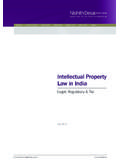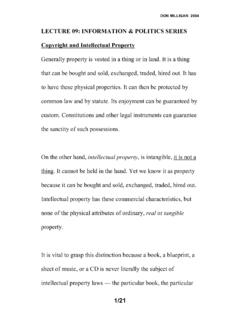Transcription of A Survey of the Major Issues Intellectual Property …
1 Intellectual Property rights : A Survey of the Major Issues A Report for the Asia Business Council By Minxin Pei, Carnegie Endowment for International Peace September 2005. Executive Summary The protection of Intellectual Property rights (IPR) has become one of the most contentious Issues in global commerce. IPR-related disputes dominate not only trade among nations, but business within nations. Several trends globalization of technology and skill, emergence of new technologies, and the rapid development of emerging economies have jointly elevated the importance of IPR protection, both politically and commercially.
2 This Survey summarizes the most salient IPR Issues , such as the economic impact of weak protection of IPR, outdated patent systems in developed economies, tensions between developed countries and developing countries over IPR protection, government and business responses, and proposed reforms. Background1. For all intents and purposes, IPR protection was not a Major international trade issue prior to the 1990s and for good reason. Prior to the end of the Cold War and the advent of accelerated globalization and the information revolution in the 1990s, the protection of IPR remained mainly a domestic, rather than a global, issue.
3 But since the 1990s, IPR protection has assumed growing salience in international trade in general, and in the commercial relations between developed and developing countries in particular. Several trends have made IPR protection a critical business and national strategy for corporations and governments: The globalization of technology and human resources: with the rapid increases in foreign direct investment and improvement in technology, the flow of critical technologies and skills has expanded and accelerated, both within the developed world and between the developed and developing economies.
4 The movement of capital and technology has, ironically, made IPR both more valuable and vulnerable at the same time. The emergence of new technologies, in particular, rapid breakthroughs in biotechnology, the adoption of new business processes and methods, and the spread of new software, such as Napster's file-sharing program threaten entire industries. These new technologies, some of which are controversial (such as the patenting of genetic materials), have either made IPR more vulnerable or rendered the existing IPR regime obsolete.
5 The growing role of emerging markets in the global economy coincides with these countries' weak ability to protect IPR. At a fundamental level, the incentives of developing countries conflict with those of developed countries. As one scholar noted, A country would have little or no interest in protecting IPRs in products of which it is solely an imitator and intends to remain so here the 1. What is IPR? In this Survey , IPR includes patents, copyrights, and trademarks. 1. national interest is above all consumer welfare sourcing the products as cheaply as possible.
6 2. IPR has gained commercial and political salience in recent years because the stakes involved are huge and growing. IPR violations cause job and revenue losses in rich countries. Take, for example, the case of counterfeiting, one of the most prevalent forms of IPR violation. According to the Federal Bureau of Investigation (FBI), 5-7 percent of world trade is in counterfeit goods, worth about $500 billion. Counterfeiting losses, argues the Chamber of Commerce, costs 750,000 American jobs and $200-250 billion in lost revenue for American businesses each year.
7 China, which has been accused of a leading violator of IPR, is itself a primary victim as well. According to one estimate, sales of counterfeits in China have been approximately $19-24 billion a year ( percent of GDP); another estimate puts counterfeiting at 8 percent of Chinese GDP. About 15-20 percent of all Chinese brands are victims of counterfeits. Chinese firms report that of all the counterfeits produced; only 8 percent are seized each More importantly, counterfeiting increases public safety and health risks. The World Health Organization (WHO) estimates that 10 percent of all pharmaceuticals sold worldwide are counterfeit.
8 In some developing countries, fake medicine accounts for as high as 60 percent of the drugs sold. Worldwide, sales of counterfeit vehicle parts amount to $12 billion each year, raising serious safety and liability Issues for legitimate automobile and auto parts manufacturers, in addition to damaging their brands. Besides counterfeiting, copyrights infringement and the use of pirated materials pose another challenge in the protection of IPR. According to the Office of the United States Trade Representative (OUSTR), the loss of revenue from the use of pirated copyright materials, such as motion pictures, records and music, business software, entertainment software, and books amounts to $12 billion a year for American firms.
9 In the Special 301. list published by the OUSTR in 2005, the following countries, which are placed on the priority watch list, are accused of rampant use of pirated copyright materials. 1. China ($ billion). 2. Russia ($ billion). 3. Brazil ($931 million). 4. Mexico ($870 million). 5. Italy ($795 million). 6. South Korea ($696 million). 7. Canada ($486 million). 8. India ($464 million). In terms of copyright materials being pirated, the largest category was business software ($ billion, or almost half of the lost revenue); it was followed by records and music 2.
10 Trebilcock and R. Howse, in The Regulation of International Trade. 3. Myron Brilliant, Vice President, East Asia, Chamber of Commerce, Testimony before the House Judicial Subcommittee on the Courts, the Internet and Intellectual Property , May 17, 2005;. , December 19, 2004. 2. ($ billion). Losses from pirated entertainment software ($ billion) and motion pictures ($ billion) were about the same. The rapid spread of counterfeiting and pirated copyright materials is caused by several factors, among them: Available low-cost technology enables counterfeiters to produce high-quality goods for the gray markets.










